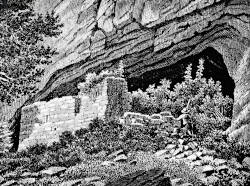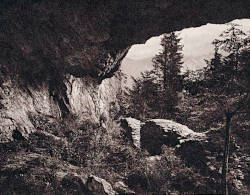Höhlenburg Grottenstein
Useful Information
| Location: |
7023 Haldenstein.
(46.8837143, 9.5219722) |
| Open: |
no restrictions. [2025] |
| Fee: |
free. [2025] |
| Classification: |
 Cave Castle Cave Castle
|
| Light: | n/a |
| Dimension: | A=848 m asl. |
| Guided tours: | self guided |
| Photography: | allowed |
| Accessibility: | no |
| Bibliography: | Anton Von Castelmur (1940): Die Burgen und Schlösser Graubündens, I. Teil: Herrschaft, Prätigau, V Dörfer, Chur und Umgebung, mit Schanfigg, Domleschg. Basel, 1940, S. 54. |
| Address: |
Chur Tourismus, Bahnhofstrasse 32, 7000 Chur, Tel: +41-81-252-18-18.
E-mail: |
| As far as we know this information was accurate when it was published (see years in brackets), but may have changed since then. Please check rates and details directly with the companies in question if you need more recent info. |
|
History
| ~1180 | castle built. |
| 1617 | first written mention by Fortunat Sprecher. |
| 1742 | written mention by Nicolin Sererhard. |
Description


Burg Grottenstein is located near Chur in the upper Rhine valley. It was built into an overhanging cliff, which is called a Balme in Switzerland. As a result, it was dubbed a Grottenburg or Balmenburg, which are both synonyms for Höhlenburg (cave castle). There is also the alternative spelling Krottenstein and Crottenstein. If you think the name is from being a cave castle you are wrong: Chrotte or Khrotta are in the local dialect Bündnerdeutsch (Grisons German) the words for toads, who found shelter under the rocky outcrop. So the name Grottenburg translates toads castle. Actually the German word Grotte for cave is much younger, it originates from the Italian grotta.
The castle was built around 1180, rather wierd is that it was first mentioned in 1617 by Fortunat Sprecher, when it was already a ruin. The name appeared first in an official document in 1672. So there is little known about its history. There is a guess though that it was owned by the Herren von Lichtenstein, who owned the nearby castle Lichtenstein, which is a normal castle, not a cave castle. This family died out around 1275, the Haldenstein family, who were closely related to them and owned the other nearby castle, died out in 1381. Most likely Grottenstein was not inhabited, it served as a last retreat in times of war.
The cave is rather wet, hence the toads, which is a result of the small spring in the northern wall of the cave. While such a spring is quite helpful during a siege, the wetness is a strang argument against continual inhabitation. The wall is 1.7 m thick and most of its is still there. There were two embrasure windows and the old high entrance at a height of 5 meters. Such entrances are quite common, it was necessary to use a wooden ladder or ropes to get tho the castle. The reason was that it was not possible to destroy the door with a ram, because it was out of reach.
To get to the castle, park in Haldenstein village, and then follow the hiking trail to Haldenstein Castle and then to Lichtenstein Castle. The turnoff to the cave castle is signposted, just before Lichtenstein Castle. The hike is about 3 km long and has an elevation gain of 270 m.
 Search DuckDuckGo for "Höhlenburg Grottenstein"
Search DuckDuckGo for "Höhlenburg Grottenstein" Google Earth Placemark
Google Earth Placemark OpenStreetMap
OpenStreetMap Grottenstein Castle - Wikipedia (visited: 18-APR-2025)
Grottenstein Castle - Wikipedia (visited: 18-APR-2025) GROTTENBURG GROTTENSTEIN
GROTTENBURG GROTTENSTEIN  (visited: 18-APR-2025)
(visited: 18-APR-2025) Index
Index Topics
Topics Hierarchical
Hierarchical Countries
Countries Maps
Maps